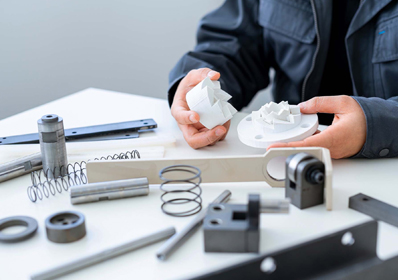Rapid prototyping
3D printing was invented to swiftly fabricate physical models based on Computer-Aided Design (CAD) designs. Rapid prototyping, enabled by 3D printing, offers substantial advantages for businesses in the product development cycle.

- Iterating Efficiently:
Challenge: Iterating through multiple versions of a design consumes significant time and resources.
Solution: Rapid prototyping allows businesses to iterate through designs swiftly, reducing the time and resources required for each iteration. This promotes a more efficient design refinement process. - Risk Mitigation in Prototype Fabrication:
Challenge: Outsourcing prototype fabrication carries the risk of design leaks.
Solution: In-house 3D printing addresses this challenge by allowing businesses to fabricate prototypes entirely on-site. This contributes to better intellectual property protection as the design remains within the company's control. - Reducing Time to Market:
Challenge: Traditional manufacturing methods lengthen the time it takes to bring a product to market.
Solution: 3D printing for rapid prototyping eliminates lead times associated with traditional manufacturing. This enables Research and Development (R&D) staff to iterate through different designs rapidly, making the overall product development process more efficient. - Efficiency in Research and Development:
Benefit: No lead times mean R&D staff can iterate through different designs rapidly, making their work more efficient. This contributes to faster innovation and adaptation to market needs. - In-House Fabrication for IP Protection:
Benefit: With in-house fabrication through 3D printing, businesses have better control over their intellectual property. Prototypes are developed within the company, reducing the risk of sensitive design information being leaked to external parties. - Shorter Time to Market:
Benefit: Fast and efficient prototyping leads to a shorter time to market. This means that new products can be introduced sooner, generating revenue for the business more rapidly. - Design Freedom:
Benefit: 3D printing provides limitless design possibilities, allowing the production of shapes that are impossible or extremely challenging to create with traditional manufacturing techniques. This flexibility opens up new creative avenues for product design.
In summary, rapid prototyping through 3D printing addresses key challenges in product development, offering benefits such as efficient design iteration, risk mitigation in prototype fabrication, reduced time to market, in-house IP protection, and the ability to explore limitless design possibilities. These advantages contribute to the overall competitiveness and innovation capabilities of businesses.
In modern consumer electronics utility is just as important as captivating design. Resin 3D printers can help achieve both. Their speed and precision allow to cost-effectively iterate through multiple concepts util the perfect balance of form and function is reached. And then they can be used for manufacturing the first short series of fully functional products to bridge the gap between the prototyping stage and going into mass production.


